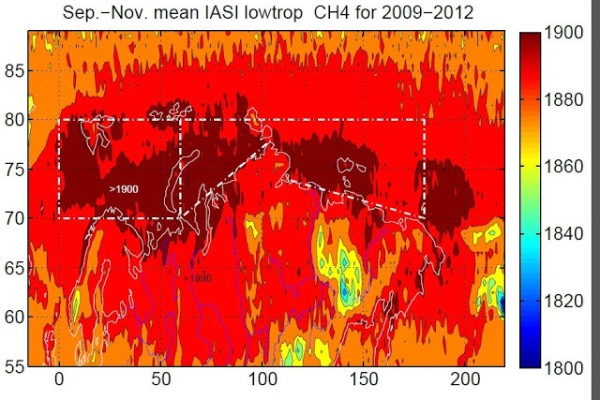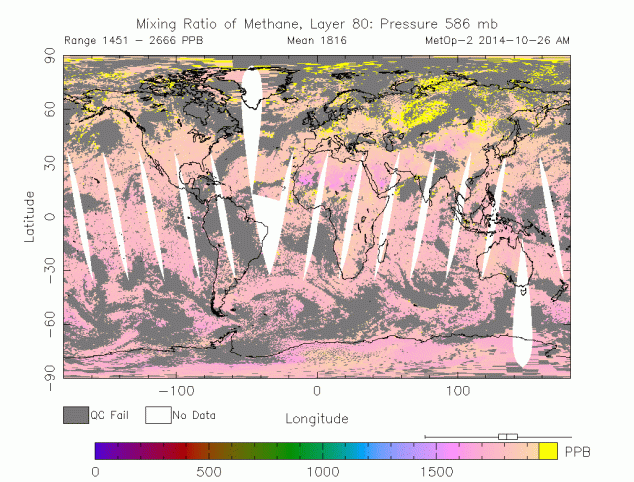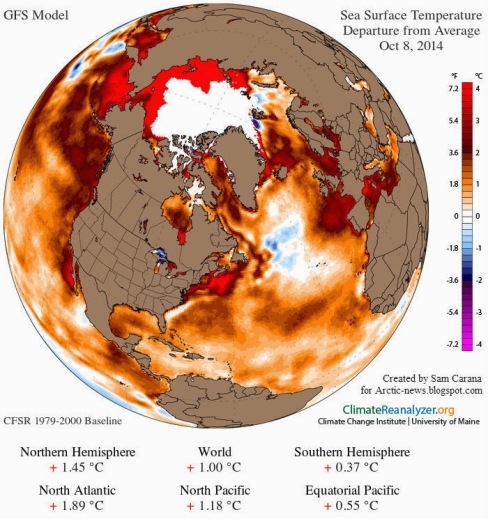Ominous
Arctic Methane Spikes Continue — 2666 ppb on October
26th
29
October, 2014
Imagine,
for a moment, the darkened and newly liberated ocean surface waters
of the Kara, Laptev, and East Siberian Seas of the early 21st Century
Anthropocene Summer.
Where
white, reflective ice existed before, now only dark blue
heat-absorbing ocean water remains. During summer time, these newly
ice-free waters absorb a far greater portion of the sun’s energy as
it contacts the ocean surface. This higher heat absorption rate is
enough to push local sea surface temperature anomalies into the range
of 4-7 C above average.
(Remnant extreme heat at Arctic Ocean surface on October 8, 2014. Extraordinary warmth in the range 0f 4-7 C above average is due to recent loss of summer sea ice in the Kara, Laptev, East Siberian and Beaufort Seas. Newly exposed dark surface waters absorb more of the sun’s rays which results in a highly visible temperature anomaly. Image source: Climate Reanalyzer. Image archived by: Arctic News.)
Some
of the excess heat penetrates deep into the water column —
telegraphing abnormal warmth to as far as 50 meters below the
surface. The extra heat is enough to contact near-shore and shallow
water deposits of frozen methane on the sea-bed. These deposits —
weakened during the long warmth of the Holocene — are now delivered
a dose of heat they haven’t experienced in hundreds of thousands or
perhaps millions of years. Some of these deposits weaken, releasing a
portion of their methane stores into the surrounding oceans which, in
turn, disgorges a fraction of this load into the atmosphere.
The
rate of release intensifies throughout summer. But during the Arctic
Fall, it reaches a peak. Then, as sea ice begins to re-form over the
surface waters, a kind of temperature inversion wedge develops. The
surface cools and the ice solidifies — forming an insulating
blanket, trapping heat. The insulating layer, in turn, pushes the
anomalously hot mid level waters toward the bottom. This process
delivers a final and powerful dose of heat to the Arctic Ocean bottom
water and sea bed.
Methane
release rates spike as the methane flooding up from the sea bed
squeezes out through cracks in the newly forming ice or bubbles up
through open waters just beyond the ice edge.
Observed
Arctic Methane Over-Burden

(Highest lower troposphere global atmospheric methane readings were found in the region of the East Siberian, Laptev and Kara seas during September through November of 2009 through 2012. Data provided by IASI. Image source: Dr. Leonid Yerganov via Arctic News.)
The
readings above show near-surface averages over a three month period
in the regions of highest release. Note that highest methane levels
occur over coastal Siberia and in the above ocean zones of
near-Russia Arctic Ocean waters.
These
measurements have been ramping higher in recent years with
near-surface readings in the range of 1950 to 2000 ppb now common for
the months of September through November in the areas affected (for
comparison, global surface averages are now in the range of 1840
ppm).
By
themselves, these measurements are evidence of a substantial Arctic
methane release. But further up in the troposphere — at the mid
cloud level — even higher levels of methane have been recorded.
For
as methane releases from the sea and land surface, it becomes trapped
in the mid-cloud layer. There, a sandwich of cloud and moisture form
a cap beneath which methane tends to concentrate. In this layer,
readings can be quite a bit higher than surface measurements. Recent
years have shown numerous instances where methane readings in the
mid-cloud layer spiked above 2300 parts per billion.
Last
year during September, the now annual plume of methane emitting from
the Arctic Ocean pushed
readings as high as 2571 parts per billion at this level of the
atmosphere.
It was a reading more than 700 parts per billion above the global
surface average. A spike fueled by the anomalously high rates of
methane emission from the Arctic surface waters and Siberian tundra
during the Fall of 2013.
This
year, despite extraordinarily spotty coverage due to cloud
interference, the METOP sensor found Arctic methane concentrations in
the range of 2666 parts per billion in the mid cloud layer. The spike
occurred just this past Sunday and exceeds the September 2013 spike
by 95 parts per billion — a level more than 800 parts per billion
above current global surface averages.

(Arctic methane spikes to 2666 parts per billion in the mid-cloud layer on Sunday October 26. Image source: OSPO/METOP.)
In
combination, observations of a rapidly warming Arctic Ocean and
observations of Arctic methane readings between 6 and 60 percent
above the global average in near surface regions and in the mid cloud
layer are a clear signal that human-caused Arctic warming is forcing
an ever-greater methane release. To a greater and greater extent,
large carbon stores are being weakened and tapped by the various
mechanisms that are an up-shot of human warming. The location of
these large-scale releases, as observed in the satellite record, is
confirmation of ground and ocean based observations conducted by
Arctic researchers such as Dr. Semiletov and Shakhova. And the
releases themselves may well be some validation of our more dire
concerns.
This
new spike is yet more evidence of a sizeable, anthropogenic-spurred,
release that is impacting not only regional methane levels, but
global levels as well. Whether this newly observed release is part of
a slow global response to the initial human heat forcing — one that
will take centuries to fully emerge — or is part of a much more
rapid and dangerous response to an also very rapid human heat forcing
is now unclear.
What
is clear is that feedbacks to the human heat forcing are now starting
to become plainly visible. That they are providing evidence of a
stronger release from some sources on a yearly basis. A troubling
amplifying feedback to the already dangerous and extraordinary human
emission. One that should serve both as a warning and as a spur to
reduce and eliminate human greenhouse gas emissions from all sources
and to switch energy systems away from fossil fuels as swiftly as
possible.
Link:




No comments:
Post a Comment
Note: only a member of this blog may post a comment.